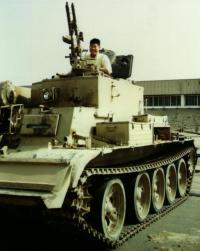Paul’s (brief) Navy career
Where…
I received my commission at the Naval ROTC unit at U.C. Berkeley in 1989. Before commissioning, I served on summer training cruises on USS SCULPIN (SSN 590) and USS BELLEAU WOOD, completed a one-year “leave of absence for graduate study” program (earning my MSCS at Berkeley in 1988-1989), and was selected for the Burke program for later graduate study.
After commissioning, I spent a few months at the Division Officer Afloat course in Coronado, CA. I was then detailed to USS MERRILL (DD 976), a Spruance-class destroyer based at the Naval Station in San Diego, CA. During my tour, MERRILL deployed twice to the Arabian Gulf and once to Latin America. I also completed my qualification as a surface warfare officer.
In 1991, MERRILL arrived in the Arabian Gulf after the DESERT STORM ceasefire, but in time to serve as the Coalition minesweeping forces flagship.
In post-Cold War 1992, I took advantage of a (voluntary!) force reduction program, leaving active duty as a lieutenant j.g. after just over three years of service. I then completed my service obligation in the Reserves.

Sideview of the Spruance “Armored Box Launcher” (ABL) ship plan.
MERRILL was an odd beast. As the test ship for the Navy’s Tomahawk cruise missile program, she had not participated in the Pacific Fleet deployment rotation and had actually never received ROH (regular overhaul, a process most warships go through every 3-4 years in order to receive equipment updates and major repairs). Her Tomahawk armored box launchers, combined with her CLASSIC OUTBOARD sensor suite, made her useful for the Navy’s main missions in the Gulf. On the other hand, her aging tactical weapons/sensor suite made her a bit problematic for her nominal mission areas (i.e., sinking enemy submarines and surface ships). More importantly for her crew, her somewhat nominal anti-aircraft capabilities made duty in the North Arabian Gulf fairly trying.
MERRILL was decommissioned in 1998, along with the other ABL-plan Spruances. (The Navy apparently decided that it would be better to scrap them than to pay for installation of the modern Vertical Launching System, as the ABL-plan Spruances decommissioned well ahead of their peers. And as of late 2005, the VLS-plan Spruances were gone anyway.) MERRILL was sunk as a target in August 2003, near Hawaii.
What…
Surface Warfare Officers School (1989)
Anti-Submarine Warfare Officer (1989-1990)
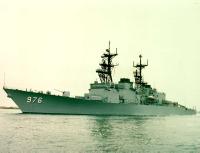
Special Sea & Anchor Detail on a hazy day, San Diego, 1989.
The background appears to be NAS North Island.
CIWS has been installed and the EARNEST WILL color scheme
has been retained: white-topped launchers, black masts and high-hats.
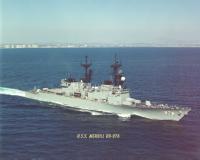
MERRILL underway off of Southern California, 1989.
Arabian Gulf deployment in support of Joint Task Force, Middle East (1989-1990)
It turned out MERRILL was going to deploy right after my graduation from SWOS; if I had attended the various follow-up technical schools to which I had been detailed, I would have missed most of the deployment. Foolishly, I skipped the additional schools and went straight to the ship… I say foolishly because I ended up as ASWO while having to learn about ASW on the job. This became sort of problematic when we tried to do ASW exercises on the way over to the Gulf. I did eventually learn ASW (becoming one of two ASW evaluators and the only junior officer with the towed-array BA2 AQD on the ship) but it was all done the hard way…
Partway to the Gulf in December 1989, we were caught up in Operation CLASSIC RESOLVE, the U.S. response to an attempted coup in the Republic of the Phillipines. We didn’t do much except get underway in case the RP Navy decided to do something.
We briefly stopped in Hong Kong.
Although Operation EARNEST WILL was in force through mid-1990, the “tanker war” stuff had mostly stopped in 1988 (after Operation PRAYING MANTIS, in which MERRILL had participated during a previous deployment, and the subsequent Iran Air 655 tragedy).
However, things got briefly exciting in February 1990 when we were called upon to assist the tanker M/V SURF CITY, which had suffered a mysterious explosion and resulting fire at sea. (Years later the NTSB decided that the explosion had been an accident, but at the time it was not clear whether she had been hit by a mine or by hostile fire.) Again, we did very little but warn off passers-by as rescue/salvage units took off the crew and put out the fire.
On the way back, we stopped in Thailand.
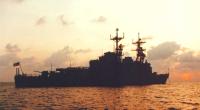
MERRILL anchored off of Phuket Island, Thailand, 1990.
COMNAVSURFPAC BZ for ROOFTOP ASW training excellence, LAMPS-I (1990)
After returning from deployment, the AN/SQR-15 Towed Array Sonar System (TASS) was installed on MERRILL. (We had no permanently-installed AN/SQR-19 TACTAS, as did most ships of our class.) The highly-experienced TASS contingent boosted our ASW readiness tremendously.
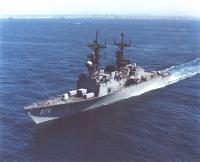
MERRILL underway off of Southern California, 1990.
The AN/SQR-15 TASS has been mounted on the port fantail.
Gunnery Officer (1990-1991)
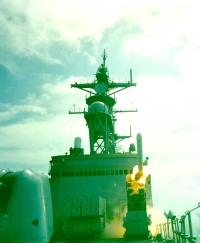
Tomahawk test shot, Point Mugu, 1990.
Note the new color scheme: all gray.
(I'm on watch in the pilothouse.)
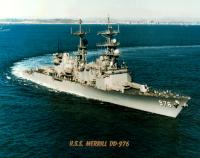
MERRILL underway off of San Diego, 1991.
Point Loma and North Island are in the background.
Arabian Gulf deployment with the USS ABRAHAM LINCOLN (CVN 72) battle group (1991)
On the way over to the Gulf, we were caught up in Operation FIERY VIGIL, the U.S. humanitarian response to the eruption of Mount Pinatubo in the Republic of the Phillipines. We hauled civilians from the Subic area to Cebu.
On the way to the Gulf, we stopped in Singapore.
Service with the Arabian Gulf Mine Counter Measures Group in support of Operation DESERT STORM (1991)
We arrived well after the shooting stopped, but post-hostilities cleanup operations (such as minesweeping) continued for months after the February ceasefire.

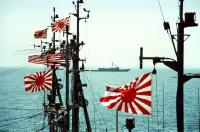
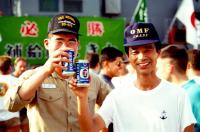
Coalition Mine Counter Measures Group, North Arabian Gulf, 1991.
Celebrating the clearance of the last Mine Danger Area.
We also stopped in Bahrain, Saudi Arabia, and Dubai. (When visiting Bahrain, which we did repeatedly, we’d generally tie up at [Mina Sulman][mina sulman], south of the capital of Manama. In Saudi Arabia, we tied up in Jubail. The main port in Dubai is Jebel Ali, considerably to the south of the city of Dubai.)
On the way back, we stopped in Hong Kong.
Communications Officer (1991-1992)
Counter-narcotics deployment to Central America in support of Joint Task Force FOUR
In spite of optempo, we were chosen to do our part in the War on Drugs. It really was like a war in the sense that we operated much as we would in the Gulf (integrated command and control nets, active and passive electronic surveillance, etc.). Very different rules of engagement, of course.
This meant we got to visit some of the Pacific ports of Panama and Guatemala. On occasion, this meant navigating unpaved streets filled with surly cops with submachine guns as well as remarkably large black pigs.
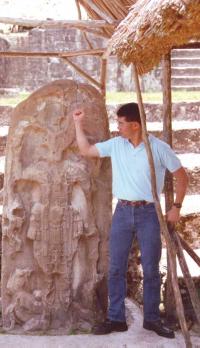
A visit to Tikal (via Puerto Quetzal, Guatemala), 1992.
Law enforcement operations with USCGC MORGENTHAU (WHEC 722) in support of Joint Task Force FIVE and Coast Guard District ELEVEN
We were apparently so simpatico with our JTF4 Coast Guard detachment that they came back to us when we were briefly sent out again, this time in company with a Coast Guard cutter. We caught some cocaine smugglers while on patrol, though not before they dumped most of their cargo over the side.
Regular overhaul, Naval Shipyard Long Beach
I processed out right after the ship started its first-ever ROH in 1992.
How well…
My service record, as indicated by my “ribbon rack,” was singularly undistinguished.

![]()
![]()
![]()
![]()
![]()
![]()
![]()
![]()
![]()
- Joint Meritorious Unit Award
For service in Operation FIERY VIGIL (Republic of the Phillipines, 1991). - Navy Unit Commendation
For service in support of USMCMGRU and Operation DESERT STORM (North Arabian Gulf, 1991). - Battle “E” Ribbon
For unit battle-readiness, as measured by peacetime exercises. - National Defense Service Medal
For service in support of Operation DESERT STORM (North Arabian Gulf, 1991). - Armed Forces Expeditionary Medal
For service in support of Operation EARNEST WILL (South Arabian Gulf, 1989). - Southwest Asia Service Medal
with bronze star
For service in support of Operation DESERT STORM (North Arabian Gulf, 1991). - Sea Service Deployment Ribbon
with bronze star
For service in two full-length overseas deployments (South Arabian Gulf, 1989; North Arabian Gulf, 1991). - Kuwait Liberation Medal (Kuwait)
For service in support of Operation DESERT STORM (North Arabian Gulf, 1991). - Expert Rifleman Medal
with Sharpshooter “S”
For qualification with the M16 rifle (1985).
